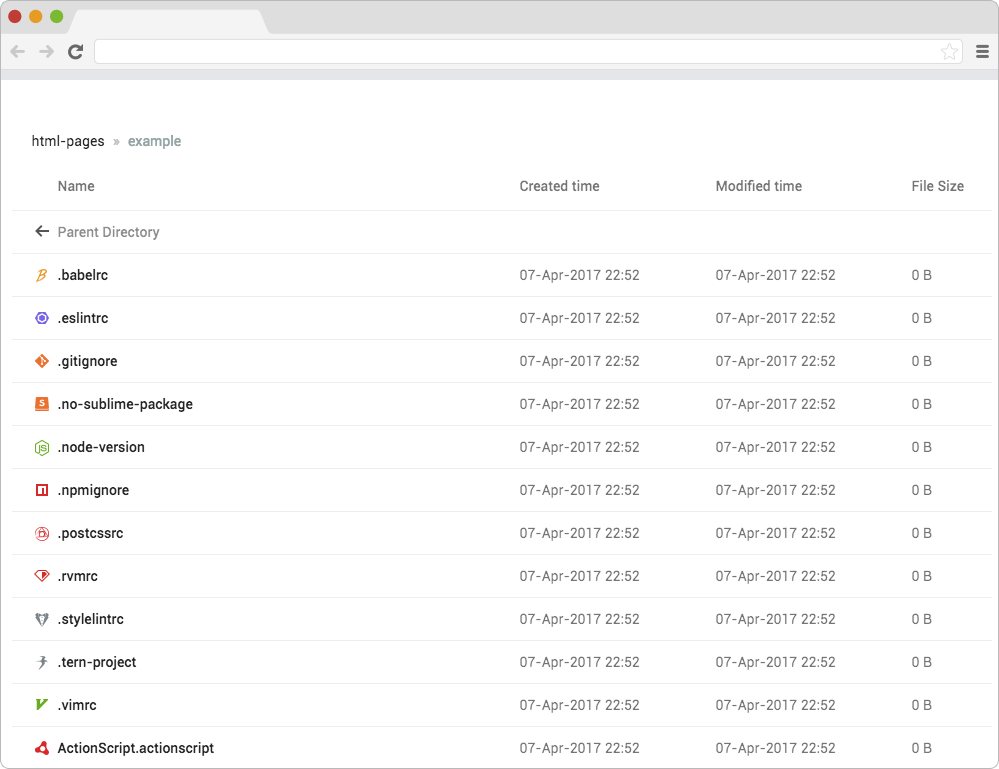HTML Pages
Simple development http server for file serving and directory listing made by a Designer. Use it for hacking your HTML/JavaScript/CSS files, but not for deploying your final site.
Visit HTML Pages »

Table of contents
Status
Quick start
Each of us already wanted to share a certain directory on our network by running just a command little command, Am I right? Then this module is exactly what you're looking for: It provides a beautiful interface for listing the directory's contents and switching into sub folders.
In addition, it's also awesome because it comes to serving static sites. If a directory contains an index.html, html-pages will automatically render it instead of serving directory contents, and will serve any .html file as a rendered page instead of file's content as plaintext.
Another huge reason to use this package is that AJAX requests don't work with the file:// protocol due to security restrictions, i.e. you need a server if your site fetches content through JavaScript.
Installation
You need to have node.js (>v.6.6.0) and npm installed. You should probably install this globally.
Npm way
npm install -g html-pagesThis will install html-pages globally so that it may be run from the command line.
Manual way
git clone https://github.com/danielcardoso/html-pagescd html-pagesnpm install # Local dependencies if you want to hack npm install -g # Install globally Usage from command line
You just have to call the command html-pages in your project's directory. Alternatively you can add the path to be a command line parameter.
Command line parameters
Run this command to see a list of all available options:
html-pages --helpOptions
-a, --auth— Enables http-auth using thePAGES_USERandPAGES_PASSWORDenvironment variables-b, --browserstring — Specify browser to use instead of system default-c, --cachenumber — Time in milliseconds for caching files in the browser (defaults to 3600)-C, --cors— Setup CORS headers to allow requests from any origin-d, --directory-indexfile — The index file of a directory. Set to empty""to always show the directory listing (defaults to index.html)-h, --help— Output usage information-i, --ignorestring/array — Files and directories to ignore. Use a string (comma-separated string for paths to ignore) if your are using the command line and an array if you are calling it via API-L, --layoutstring — Specify the page layout. Available optionsgridorlist. (defaults to grid)-l, --log-levelstring — Display logs in the console. The possible values aresilent,error,warn,info,debug. Any logs of a higher level than the setting are shown. If you define it asinfo, it will showwarnanderroroutputs also. (defaults toinfo)silent- It will suppress all application logging. The Fatal errors will be shown.error- Any error which is fatal to the operation, but not the service or application (can't open a required file, missing data, etc.). These errors will force user (administrator, or direct user) intervention. These are usually reserved (in my apps) for incorrect connection strings, missing services, etc.warn- Anything that can potentially cause application oddities, but for which I am automatically recovering. (Such as switching from a primary to backup server, retrying an operation, missing secondary data, etc.)info- Generally useful information to log (service start/stop, configuration assumptions, etc). Info I want to always have available but usually don't care about under normal circumstances. This is my out-of-the-box config level.debug- Information that is diagnostically helpful to people more than just developers (IT, sysadmins, etc.).
-o, --open— Open browser window after starting the server--no-cache— Disabled the caching files in the browser--no-clipboard— Don't copy address to clipboard--no-listing— Turn off the directory listings--no-notifications— Suppress automatic notifications launching--no-port-scan— Disabled the port scanning when the selected port is already in use-p, --portnumber — Port to listen on (defaults to 8084)-r, --rootstring — The root directory (defaults to ./)-S, --silent— Setlog-leveltosilentmode-u, --unzipped— Disable GZIP compression-V, --verbose— Setlog-leveltodebugmode-v, --version— Output the version number
Default options:
If a file ~/.html-pages.json exists it will be loaded and used as default options for html-pages on the command line. See Options for option names.
Authentication
If you set the --auth flag, this package will look for a username and password in the PAGES_USER and PAGES_PASSWORD environment variables.
As an example, this is how such a command could look like:
PAGES_USER=daniel PAGES_PASSWORD=1904 html-pages --authUsage from node
You can also use the package inside your application. Just load it:
const pages = And call it with flags (check Command line parameters for the full list):
const pagesServer = To stop the server just use the method:
pagesServerWhat next?
- Enable HTTPS support;
- Add Proxy support;
- Provide a /robots.txt (whose content defaults to
'User-agent: *\nDisallow: /'); - Improve HTML errors;
Version history
- v2.1.0
- Security updates
- v2.0.0
- Specify the page layout. Available options
gridorlist - Add
hostaddress to bind to. By default it supports "any address" - Add
localhostoption to work only locally, blocking external connections - Disable notification by default
- Minor improvements
- Specify the page layout. Available options
- v1.7.0
- Logs all requests: add options
log-level,verboseandsilentto filter the logs - Minor improvements
- Logs all requests: add options
- v1.6.0
- Replace the option
--no-browserwith the--openor-o - Added some logging to console
- Improve HTML errors
- Minor improvements
- Replace the option
- v1.5.0
- Using Travis CI (Linux and Mac Build Status)
- Using AppVeyor (Windows Build Status)
- CORS support
- Load initial settings from
~/.html-pages.jsonif exists - Minor improvements
- Improve tests
- v1.4.0
- Update dependencies
- v1.3.0
- Code Refactoring
- v1.2.0
- Add web browser launching support:
- it uses opn to allow opening links in different browsers;
- Minor improvements
- Add web browser launching support:
- v1.1.0
- Add icons with the file types to the directory listing;
- Add example files;
- v1.0.0
- Initial release
Author
Daniel Cardoso (@DanielCardoso) - DanielCardoso.net








